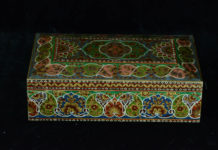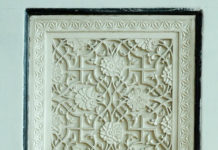One of the most original types of traditional handicrafts in Tajikistan is kundal, a polychrome decorative wall painting of glue paints with gilded relief details of the ornament. This decoration technique was created in Central Asia in the late fourteenth to early fifteenth century. Kundal was successfully and very widely used to decorate Central Asian buildings until the end of the nineteenth century.
A striking example is the madrassa of Tillya-Kari (seventeenth century) in Samarkand located on Registan Square, the surface of the walls and vaults of which are covered with a kundal painting with abundant use of gold. In Dushanbe, in the interior and exterior decoration of the tea house Chaikhana Rohat that was built in 1946 and the modern architectural construction of the “Kokhi Navruz”, erected in 2014, the kundal painting was also used.
Kundal is a laborious and expensive technique. A mixture of cement and special glue is prepared in advance. Earlier the main component of the mixture was red clay. A fine brush is applied on top of the ornament with cement mortar. It can be of different thicknesses. After the first layer, one more must be applied. By how the mixture is applied, you can determine the professionalism of the master. Previously, the mixture was covered with gold plating. Today the surface of the cement painting is covered with paints. In pre-Islamic period kundal painting could depict people, afterwards only animals are drawn.
In kundal, Tajik craftsmen often use three groups of ornaments:
- Islimi (image of floral elements) shoots, buds, flowers, leaves, fruits of fruit trees, a box of cotton and others.
- Girekh (geometric ornament from straight lines, such as grids, asterisks, figures, stars that can have from 3 to 16 points)
- Murakkab (complex or combined ornament) formed from the joint use of floral elements and geometric shapes
Modern artists of Tajikistan use kundal in the decoration of interiors and in the design of chess, caskets, dishes and other souvenirs. Easel kundal appeared in the middle of the twentieth century and enriched ancient traditional ornamental motifs by portraits and thematic compositions. In nineties, kundal technique have been applied in miniature painting.
The students are trained in Kundal technique at the State Institute of Fine Arts and Design, in the Art College of M. Olimov and in the Art College of Sadirhon Hafiz in the city of Khojent. A new generation of masters of kundal decorative wall painting include Ravshan Karimzoda, Komron Karimzoda, Rakibov Muhammadkarim, Rakibov Aziz, Sanginov Rustam, Jumaev Alisher.
Source: Zulola Boimurodova, the chief specialist of the Fine and Applied Arts, National Museum of Tajikistan





